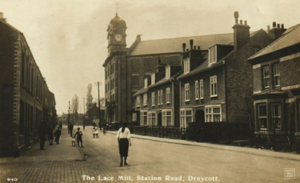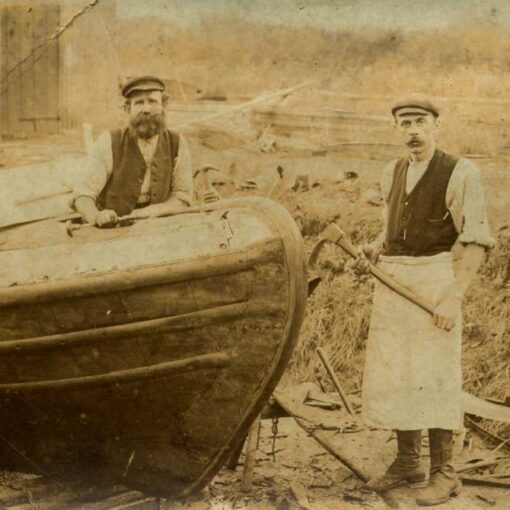Charles ‘Tim’ Tyler (1906-2005) was born in Draycott and visited as a child, but lived in London and then Sussex. In 2000 (aged 95) he wrote to the Sawley Historical Society with his memories of Draycott around the time of the First World War.
Charles Tyler’s Letter
At the turn of the 20″ century, Draycott was a small village in east Derbyshire, on the old Roman road (now A6005), between Derby and Nottingham.
I was born in the village on August 2″, 1906, but my memories only relate to the period 1914-1919, so this needs explanation.
Father and mother started their life together in Brussels, where Father was accountant to a small new company called The Gramophone Company — trademark “His Master’s Voice”. After a miscarriage, Mother, pregnant again, had to decide whether to go with Father who has just been appointed as manager of a new branch of HMV in Alexandria, Egypt.

Determined to have her children born in England, she chose to go to her brother John’s house in Draycott. He was manager of a cotton mill in the hamlet of Church Wilne, about a couple of miles away on the banks of the river Derwent, which provided power for the mill.
My cousin Lily, eldest of Uncle John’s eight children, has told me of the excitement in the house during my arrival. A little later I was christened in St Chad’s, Wilne, a 12″-century church built on the site of a previous Saxon church. At that time the population of Wilne was about 90, living in about 30 dwellings, mostly cottages.
Mother then sailed off to join Father with me in tow, my first seafaring experience. Mother told me it was a very rough trip, and for my comfort the crew made a small hammock.
After only two years in Egypt Father was again moved as manager to take charge of the much larger business in Russia, first in Moscow, later in Tiflis (now Tbilisi), the capital of Georgia in the Caucasus.
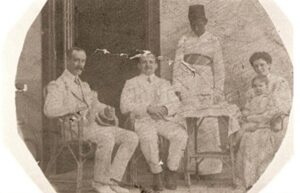
And Mother was again pregnant, and once again chose to go to her brother’s house, now in Manchester, where he was manager of a larger cotton mill, and my sister Edith was born on August 5″, 1908.
Once again Mother set off to join Father, this time with two of us, 2¼ and three months old, across Europe by train – France, Belgium, Germany, Poland and Russia – with poor French and absolutely not a world of German, Polish or Russian, with two babies.
I am told I fell out of a top bunk bed on the journey, which no doubt says a lot about later shortcomings!
The family were very happy in Russia and when we call came home on leave six years later, at the age of eight I was put to school in New Brighton, the Wirral, opposite Liverpool on the Mersey river, little aware of what lay ahead.
In the event the First World War and later Russian Revolution prevented Father and Mother getting back to England until 1919: and it was during this period, 1914-1919, that I spent holidays with Mother’s sister Elizabeth – Auntie Lizzie.
She had married Alexander Smith – Uncle Sandy – one of the managers of a large lace mill in Draycott, the remains of which can still be seen, I am told.
So now I come to my memories of Draycott in those years
Auntie’s first home was above a haberdashery shop which she managed, close to the lace mill.
Later they moved to a larger house called Middlebrook, on Derby Road, quite close to Lauderdale where I was born.
It was a three-bedroom house: entrance hall, sitting room, dining room, kitchen and bathrooms; gas lighting; solid fuel fires; the kitchen range also solid fuel; large copper for washing clothes and providing hot water (transferred by bucket) for the bath; cold water from the one kitchen tap.
The family consisted of two boys — Alex and Willie — and three girls, Gertrude, Nellie and Grace [Note 3]. So Uncle and Auntie occupied one bedroom, the two boys in another (three boys when I was there, when we slept three in a bed, with me in the middle), and the three girls in the third bedroom.
The lavatory was outdoors and there was a small garden where Auntie grew fruit and vegetables, and a corner for cocks and hens, with chickens at Easter, usually Rhode Island Reds.
Although the whole place was chockfull, it was always busy, happy and good-tempered as I remember it. Everyone sang around the piano, played by the girls. Everyone seemed to have tuneful voices, especially Nelly, a rich mezzo-soprano.
The boys worked for the Midland Railway, which ran from London St Pancras through Leicester, Loughborough, Long Eaton and Draycott to Derby and beyond. The older girls worked sometimes on munitions during the war; Grace, nearer my age, was still at school.
Family History Notes
Charles’ parents were Frederick Tyler (born 1873, Grantham) and Sarah Ellen (Sally) Kershaw (born 1873, Manchester).
John Kershaw was from Manchester but moved to Church Wilne to become an overlooker and then manager of the Doubling Hall, at Mr Astle’s cotton mill. In 1903/4 when they moved to a house on Derby Road, at the end of Draycott, which Mr Astle, the mill owner, had built for them.
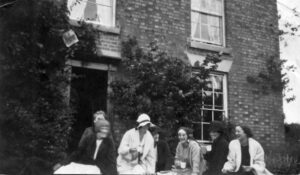
They called the house ‘Lauderdale’. Sarah Ellen’s mother was Mary Ann Lidderdale, whose parents came from Kirkcudbright in Southwest Scotland. Lidderdale is thought to be a variant of Lauderdale. In 1904 John helped a boy who was drowning in the nearby Derby Canal. The next year, a 12-year-old girl who fell from a railway carriage was bought to the house. Charles Tyler was born there in 1906.
Actually, Lily wasn’t the oldest of John’s children. Her brother John died on the Somme in 1916.
John had immersed himself in village life, joining the parish council and the board of guardians of the Shardlow Union. But then he fell out with Mr Astle and moved back to Manchester – to ‘Wilne Villas’ in Droysden.
Sarah Ellen and the children came home during the war, but Fred stayed, and was there during 1917 Bolshevik revolution and didn’t get back to the UK until 1919.
Lizzie Kershaw had married Sandy Smith in 1892. On moving from Manchester to Derbyshire they first lived next to Wilne Church with, or near, her brother John.
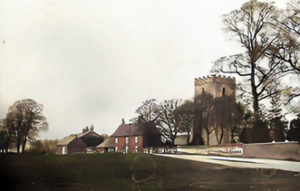
By 1901 Sandy & Lizzie had moved to Station Road, Draycott, where they lived above the haberdashery shop Lizzie managed, close to the lace mill. They later moved to ‘Middlebrook’ 130 Derby Road.
Alex Smith’s daughter Audrey Beers kept the Draycott Post Office for many years.
Gertude went to czarist Russia to help look after the children. She later worked as a typist for the Midland Railway in Derby before marrying George Sandland. They are buried in Sawley churchyard. Nellie once auditioned for the D’Oyly Carte Opera Company. Grace moved to Sawley after marrying Cecil Kingscott.

The Hollingsworths lived at Bankfield House, between Derby Road and the River Derwent.
After the first world war Charles’ parents were at different times in Neuilly (on the outskirts of Paris) and Brussels. Fred was often the local British consul, as well as the HMV agent. In 1940 were in Cherbourg and involved in the evacuation of British troops as France fell.
Charles became a naval cadet and served in the Royal Navy in the Second World War.
